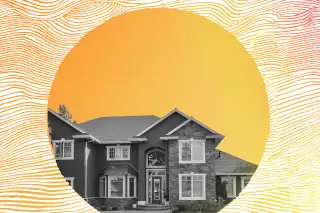Today's Best Mortgage and Refinance Rates: December 15, 2020| Rates Increase

The share of loans in forbearance declined for the first time in three weeks, but the slowing economy are causing an increase in plan entries.
Meanwhile, mortgage rates ticked up from yesterday.
Today's Mortgage Rates
The average rate for a 30-year fixed-rate purchase mortgage was 3.108% on Monday. On Friday, the average rate was 3.092%.
Money's mortgage rates include data from over 8,000 lenders across the United States and are updated daily. These rates include discount points and represent what a borrower with a 20% down payment and 700 credit scores — roughly the national average FICO score — would have been quoted.
| Mortgage Rates for December 15, 2020 |
| Loan type | Average Rate |
| 30-Year Fixed Loan | 3.108% |
| 15-Year Fixed Loan | 2.347% |
| 30-Year FHA Loan | 3.328% |
| 30-Year VA Loan | 3.41% |
| 30-Year Jumbo Loan | 3.546% |
Source: Money | Date: Dec. 14, 2020 | Rates assume a credit score of 700
How do I get the best mortgage rates?
Mortgage rates vary from state to state. On Monday, borrowers in Alaska were quoted the lowest mortgage rates — at 2.978%. People looking for mortgages in Arizona saw the highest average rate at 3.249%.
Nationwide, borrowers with the highest credit scores, 740 and above, were quoted rates averaging 2.829%, while those with credit of 620 or below were shown rates of 4.642%.
You may be able to negotiate a lower rate if you shop around or if you have other accounts with the lender. (Money's picks for the best mortgage lenders are here.) Currently, some lenders are hiking up advertised rates to keep demand in check, so you may be offered a lower rate if you reach out directly.
Freddie Mac's widely quoted Primary Mortgage Market Survey put rates at 2.71% with 0.7 points paid for the week ending December 10. Rates remained unchanged from last week's new record low. The mortgage purchaser's weekly survey reflects borrowers who put 20% down on conforming loans and have excellent credit.
Today's Mortgage Refinance Rates
Money's survey also shows that the offered rate for a 30-year refinance for someone with a 740 credit score was 3.317% on Monday. Last December, the average mortgage rate (including fees) was 3.88%.
| Refinance Rates for December 15, 2020 |
| Loan type | Average Rate |
| 30-Year Fixed Loan | 3.317% |
| 15-Year Fixed Loan | 2.631% |
| 30-Year FHA Loan | 3.799% |
| 30-Year VA Loan | 3.896% |
| 30-Year Jumbo Loan | 3.538% |
Source: Money | Date: Dec. 14, 2020 | Rates assume a credit score of 740
A homeowner with a $200,000 mortgage balance currently paying 3.88% on a 30-year could potentially cut their monthly payment from about $940 to about $878 by financing at the current lower rates. To determine if it's worth it to refinance your mortgage, also consider the closing fees you paid on your current mortgage, how much your new lender is charging and how long you have left on your loan term. (Our picks for the best lenders for refinancing are here).
What else is happening in the housing market today
The overall share of mortgage loans in forbearance plans decreased by 6 basis points to 5.48% for the week ending December 6, according to the Mortgage Bankers Association. With an estimated 2.7 million homeowners in forbearance and more requests for loan deferral coming in, however, the industry group struck a cautious tone.
"Compared to the last two months, more homeowners exiting forbearance are using a modification — a sign that they have not been able to fully get back on their feet, even if they are working again," said Mike Fratantoni, chief economist for the MBA.
Despite the overall decrease, the MBA's data shows that new forbearance requests reached their highest level since August 2, and call volumes to servicer's call centers reached their highest level since April 19.
"The latest economic data is showing a slowdown, particularly an increase in layoffs and long-term unemployment. Coupled with the latest surge in COVID-19 cases, it is not surprising to see more homeowners seeking relief," noted Fratantoni.
More people with loans guaranteed by Fannie Mae and Freddie Mac exited the payment deferral program, as did those with government-backed Ginnie Mae loans. However, the share of deferred portfolio loans and private-label securities increased by 19 basis points to 8.89%.
Part of the Coronavirus Aid, Relief and Economic Security Act, mortgage forbearance plans grant up to a year pause on monthly payments for people experiencing hardship due to the pandemic. An initial 180 days period can be extended for an additional 180 days if the homeowner requests an extension.
Nearly 79% of loans in forbearance were in an extension, while approximately 19% were in the initial stages. The remaining percentage represents loans that re-entered forbearance.
Mortgage Term of the Week
Understanding the lingo can be key to avoiding mistakes when you are buying a home or refinancing your mortgage. For more read: Everything You Need to Know About Mortgage Rates in 2020.
Interest rate: The amount of money a lender charges a borrower for a loan, expressed as a percentage of the loan principal and usually noted on an annual basis, known as the annual percentage rate.
Bottom line:
Why This Winter Should Be One of the Best Ever for Home Sales
A Controversial New Fee Adds an Extra $1,400 to the Average Mortgage Refinance
Worried About Foreclosure? This Key Formula Can Tell You if You're at Risk